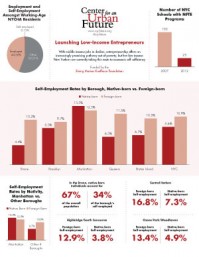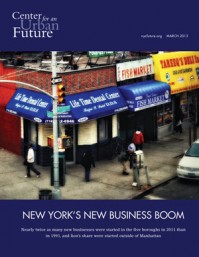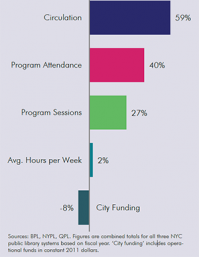Report - June 2013
Completion DayCommunity colleges are a critical resource for a growing number of New Yorkers and a key component of the state's economic competitiveness. But they are taken for granted by policymakers and continue to face enormous challenges in graduating students.
Data - June 2013
Data from Completion DaySelected charts and graphs from the Center for an Urban Future's 2013 report Completion Day. The report found that community colleges are a critical resource for a growing number of New Yorkers and a key component of the state's economic competitiveness but are taken for granted by policymakers and continue to face enormous challenges in graduating students.
Data - May 2013
Seeding NYC’s Startup SuccessOver the past decade, the NYC region’s share of all venture capital deals in the U.S. more than doubled, from 5.3 percent to 11.4 percent. During the same period, New England’s share fell from 14.8 percent to 10.2 percent and Silicon Valley’s rose slightly, from 28.6 percent to 31.7 percent.
Commentary/Op-Ed - May 2013
8 Ways to Grow New York’s Design SectorLaunching a citywide design festival is a big first step, but there is more the city can do to harness New York’s competitive advantage in design.
Report - April 2013
Launching Low-Income EntrepreneursWith middle-income jobs in decline, entrepreneurship offers an increasingly promising pathway out of poverty; but few low-income New Yorkers are currently taking this route to economic self-sufficiency.
Data - April 2013
Data from Launching Low-Income EntrepreneursSelected charts and graphs from the Center for an Urban Future's major April 2013 report on low-income entrepreneurs. The report found that with middle-income jobs in decline, entrepreneurship offers an increasingly promising pathway out of poverty; but few low-income New Yorkers are currently taking this route to economic self-sufficiency.
Data - April 2013
Low-Wage Jobs, 2012Over the past five years, the number of New Yorkers who work in low-wage jobs has steadily increased, with more than a third of adults in the city—and nearly half in the Bronx—now stuck in low-paying occupations.
Data - March 2013
Is Manufacturing Back in Brooklyn?Like the rest of New York City, Brooklyn has been bleeding manufacturing jobs for decades. But in the last few years, manufacturing employment in the borough is up slightly, even though the average company now has considerably fewer employees on average. Is Brooklyn in a new age of entrepreneurial manufacturing?
Data - March 2013
New York’s New Business BoomNearly twice as many new businesses were started in the five boroughs in 2011 than in 1991, and the lion’s share were started outside of Manhattan.
Data - March 2013
Legal LimboNew York remains a global center for law firms, but employment in the city's legal services sector is down 3 percent over the past two decades.
Data - February 2013
Texas Two StepThere has been a huge spike in the number of New Yorkers relocating to Texas in recent years, even at a time when fewer city residents were departing for Charlotte, Atlanta, Philadelphia and other traditional destinations.
Commentary/Op-Ed - February 2013
Foster Youth and the Workforce: Next StepsRoughly half of the young people who have aged out of NYC’s foster care system aren’t working, but this policy brief outlines a handful of achievable recommendations for putting foster youth on the path to careers and productive lives.
Commentary/Op-Ed - February 2013
Time to Revamp NYC’s Workforce Development SystemNYC’s next mayor will inherit a workforce development system in far better shape than when Mayor Bloomberg took office, but it’s now time to go beyond simply placing New Yorkers into jobs and build the skills of the local workforce.
Report - January 2013
Branches of OpportunityNew York City’s public libraries are serving more people in more ways than ever before, and have become an increasingly critical part of the city’s human capital system; but they have been undervalued by policymakers and face growing threats in today’s digital age.
Data - January 2013
Data from Branches of OpportunitySelected charts and graphs from the Center for an Urban Future's major January 2013 report on NYC's public libraries. The report found that public libraries are serving more people in more ways than ever before, and have become an increasingly critical part of the city’s human capital system; but they have been undervalued by policymakers and face growing threats in today’s digital age.
Report - December 2012
State of the Chains, 2012Our fifth annual ranking of national retailers in NYC shows that the number of chain stores in New York City increased for the fifth straight year in 2012, paced by strong growth in the Bronx and continued expansion from top retailers Dunkin Donuts and Subway.
Data - August 2012
Data from Smarter Small BusinessesSelected charts and graphs from the Center for an Urban Future's August 2012 report on technology use among NYC's small businesses. The report found that far too many of NYC's small businesses still aren't using websites, online ads and other technology tools, a huge missed opportunity at a time when small firms face increasing competition from national chains and online companies.
Report - August 2012
Smarter Small BusinessesThis report finds that far too many of NYCs small businesses still arent using websites, online ads and other technology tools, a huge missed opportunity at a time when small firms face increasing competition from national chains and online companies.
Report - July 2012
Here Comes the SunThis edition of New York by the Numbers reveals that New York City lags behind the rest of the state when it comes to installing solar energy panels in residential, commercial and government buildings, but is beginning to catch up.
Commentary/Op-Ed - July 2012
GED® change will be costly for N.Y.In July 2012, the Albany Times Union published an op-ed by our senior fellow Tom Hilliard which notes that beginning in 2014 the GED® exam will cost twice as much to take and be significantly more difficult to pass, changes that will almost certainly lead to significantly fewer New Yorkers getting their GED® credential. Already, New York is 49th out of 50 states in the GED® pass rates. In the op-ed, Tom urges New York State education officials and legislators to explore alternatives to the GED® test.





















